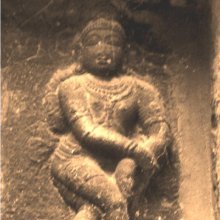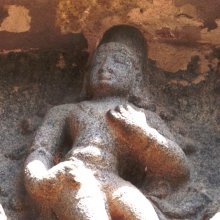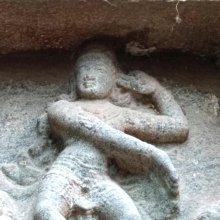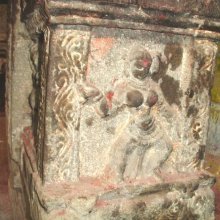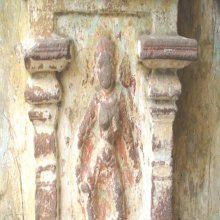Nitamba, Ni-tamu-ba, Nitambā: 24 definitions
Introduction:
Nitamba means something in Hinduism, Sanskrit, Buddhism, Pali, Marathi, Hindi. If you want to know the exact meaning, history, etymology or English translation of this term then check out the descriptions on this page. Add your comment or reference to a book if you want to contribute to this summary article.
Alternative spellings of this word include Nitamb.
Images (photo gallery)
In Hinduism
Natyashastra (theatrics and dramaturgy)
Source: Wisdom Library: Nāṭya-śāstra1) Nitamba (नितम्ब).—One of the 108 karaṇas (minor dance movement) mentioned in the Nāṭyaśāstra chapter 4. The instructions for this nitamba-karaṇa is as follows, “arms to be first thrown up and hands to have their fingers pointing upwards and the Baddhā Cārī to be observed.”. A karaṇa represents a minor dance movements and combines sthāna (standing position), cārī (foot and leg movement) and nṛttahasta (hands in dancing position).
2) Nitamba (नितम्ब) refers to a gesture (āṅgika) made with ‘dance hands’ (nṛttahasta), according to the Nāṭyaśāstra chapter 8. The hands (hasta) form a part of the human body which represents one of the six major limbs (aṅga) used in dramatic performance. With these limbs are made the various gestures (āṅgika), which form a part of the histrionic representation (abhinaya).
Source: archive.org: The mirror of gesture (abhinaya-darpana)1) One of the saṃyutta-hastāni (Twenty-six combined Hands).—Nitamba (buttock): Patāka hands face upwards, turned over, (extended from) the shoulder to the buttocks. Patron deity Agastya. Usage: weariness, descent or entry (avataraṇa), astonishment, ecstasy, etc.
2) Nitamba is one of the saṃyutta-hastāni (Twenty-seven combined Hands).
Source: archive.org: Natya ShastraNitamba (नितम्ब).—A type of gesture (āṅgika) made with dance-hands (nṛttahasta);—(Instructions): The two Patāka hands taken out from the boulder [to the hip]. The Dance-hands are to be used in forming Karaṇas.
Source: Shodhganga: Elements of Art and Architecture in the Trtiyakhanda of the Visnudharmottarapurana (natya)1) Nitamba (नितम्ब) refers to one of the thirty Nṛttahastas or “dance hand gestures” (in Indian Dramas), according to the Viṣṇudharmottarapurāṇa, an ancient Sanskrit text which (being encyclopedic in nature) deals with a variety of cultural topics such as arts, architecture, music, grammar and astronomy.—The hasta-mudrās (lit. “hand-gestures”) are very essential to denote some particular action or state in dancing and these mudrās are formed with the help of hands and fingers. In the Viṣṇudharmottarapurāṇa, thirty kinds of nṛttahastas (“dance-hand gestures”) are mentioned. e.g., nitamba. The practice of these nṛttahastas is strictly prohibited in sickness of body, in old age, in fear, drunk and anxiety.
2) Nitamba (नितम्ब) refers to one of the 108 kinds of Karaṇa (“coordination of precise movements of legs and hands”), according to the Viṣṇudharmottarapurāṇa.—Accordingly, karaṇas are the coordination of precise movements of legs and hands performed in a particular posture. The Nāṭyaśāstra also gives its view point in the same spirit. In the Viṣṇudharmottarapurāṇa, one hundred and eight kinds of karaṇas are accepted, e.g., Nitamba.

Natyashastra (नाट्यशास्त्र, nāṭyaśāstra) refers to both the ancient Indian tradition (shastra) of performing arts, (natya—theatrics, drama, dance, music), as well as the name of a Sanskrit work dealing with these subjects. It also teaches the rules for composing Dramatic plays (nataka), construction and performance of Theater, and Poetic works (kavya).
Shaivism (Shaiva philosophy)
Source: Wisdom Library: Ṣaṭsāhasra-saṃhitāNitambā (नितम्बा):—One of the twelve guṇas associated with Kanda, the fifth seat of the Svādhiṣṭhāna-chakra. According to tantric sources such as the Śrīmatottara-tantra and the Gorakṣasaṃhitā (Kādiprakaraṇa), these twelve guṇas are represented as female deities. According to the Ṣaṭsāhasrasaṃhitā however, they are explained as particular syllables. They (e.g. Nitambā) only seem to play an minor role with regard to the interpretation of the Devīcakra (first of five chakras, as taught in the Kubjikāmata-tantra).

Shaiva (शैव, śaiva) or Shaivism (śaivism) represents a tradition of Hinduism worshiping Shiva as the supreme being. Closely related to Shaktism, Shaiva literature includes a range of scriptures, including Tantras, while the root of this tradition may be traced back to the ancient Vedas.
Ayurveda (science of life)
Nighantu (Synonyms and Characteristics of Drugs and technical terms)
Source: Wisdom Library: Raj Nighantu1) Nitamba (नितम्ब) refers to the “middle part” of a mountain (giri) according to the second chapter (dharaṇyādi-varga) of the 13th-century Raj Nighantu or Rājanighaṇṭu (an Ayurvedic encyclopedia). The Dharaṇyādi-varga covers the lands, soil, mountains [viz., Nitamba], jungles and vegetation’s relations between trees and plants and substances, with their various kinds.
2) Nitamba (नितम्ब) refers to the “lower part” (of a tree), as mentioned in a list of three synonyms in the second chapter (dharaṇyādi-varga) verse 28a.
Unclassified Ayurveda definitions
Source: gurumukhi.ru: Ayurveda glossary of termsNitamba (नितम्ब):—[nitambaḥ] Buttock. The external prominences posterior to the hips

Āyurveda (आयुर्वेद, ayurveda) is a branch of Indian science dealing with medicine, herbalism, taxology, anatomy, surgery, alchemy and related topics. Traditional practice of Āyurveda in ancient India dates back to at least the first millenium BC. Literature is commonly written in Sanskrit using various poetic metres.
Shaktism (Shakta philosophy)
Source: Google Books: Manthanabhairavatantram1) Nitamba (नितम्ब) [=Nitambaja?] refers to the “hip”, corresponding the Brāhma system: one of the sixteen spiritual disciplines (darśana) issued from the limbs of the body of the Goddess, according to the Manthānabhairavatantra, a vast sprawling work that belongs to a corpus of Tantric texts concerned with the worship of the goddess Kubjikā.—[...] All spiritual disciplines, whatever the tradition, are necessarily grounded in the same energy of the Śāmbhava state. They issue, as the texts put it, from the limbs of the body of the goddess who is this energy. [...] The systems (darśana) and their corresponding places of origin in the Goddess’s body are as follows: [3) Brāhma—the hip—nitamba—nitambaja, ...].
2) Nitamba (नितम्ब) refers to the “hips”, which is associated with the Jyeṣṭhāgranthi, according to the Ṣaṭsāhasrasaṃhitā, an expansion of the Kubjikāmatatantra: the earliest popular and most authoritative Tantra of the Kubjikā cult.—Accordingly, “(4) Jyeṣṭhā’s Knot is below the hip [i.e., nitamba] and (5) Vāmā’s Knot is (above) on the other side. [...]”.

Shakta (शाक्त, śākta) or Shaktism (śāktism) represents a tradition of Hinduism where the Goddess (Devi) is revered and worshipped. Shakta literature includes a range of scriptures, including various Agamas and Tantras, although its roots may be traced back to the Vedas.
Languages of India and abroad
Pali-English dictionary
Source: BuddhaSasana: Concise Pali-English Dictionarynitamba : (m.) 1. the hip; 2. the ridge of a mountain.
Source: Sutta: The Pali Text Society's Pali-English DictionaryNitamba, (Sk. nitamba; etym. unknown) the ridge of a mountain or a glen, gully DA. I, 209. (Page 357)

Pali is the language of the Tipiṭaka, which is the sacred canon of Theravāda Buddhism and contains much of the Buddha’s speech. Closeley related to Sanskrit, both languages are used interchangeably between religions.
Marathi-English dictionary
Source: DDSA: The Molesworth Marathi and English Dictionarynitamba (नितंब).—m (S) Buttocks or posteriors (esp of a woman). 2 unc A buttock.
Source: DDSA: The Aryabhusan school dictionary, Marathi-Englishnitamba (नितंब).—m Buttocks or posteriors (esp. of a woman). A buttock.
Marathi is an Indo-European language having over 70 million native speakers people in (predominantly) Maharashtra India. Marathi, like many other Indo-Aryan languages, evolved from early forms of Prakrit, which itself is a subset of Sanskrit, one of the most ancient languages of the world.
Sanskrit dictionary
Source: DDSA: The practical Sanskrit-English dictionaryNitamba (नितम्ब).—[nibhṛtaṃ tamyate kāmukaiḥ, tamu kāṅkṣāyām]
1) The buttocks, posteriors (of a woman), (the circumference of the hip and loins); यातं यच्च नितम्बयोर्गुरुतया मन्दं विलासा- दिव (yātaṃ yacca nitambayorgurutayā mandaṃ vilāsā- diva) Ś.2.2; R.4.52;6.17; Meghadūta 43; Bhartṛhari 1.5; M.2.7.
2) The slope, ridge, side, flank of a mountain; सनाक- वनितं नितम्बरुचिरम् (sanāka- vanitaṃ nitambaruciram) (girim) Kirātārjunīya 5.27; सेव्या नितम्बाः किमु भूधराणामुत स्मरस्मेरविलासिनीनाम् (sevyā nitambāḥ kimu bhūdharāṇāmuta smarasmeravilāsinīnām) Bhartṛhari 1.19; V.4.26; Bk. 2.8;7.58.
3) A precipice.
4) The sloping bank of a river; Mahābhārata (Bombay) 1.12.12.
5) The shoulder.
6) The sounding-board of the Vīṇā.
Derivable forms: nitambaḥ (नितम्बः).
Source: Cologne Digital Sanskrit Dictionaries: Shabda-Sagara Sanskrit-English DictionaryNitamba (नितम्ब).—m.
(-mbaḥ) 1. A woman’s buttock’s. 2. The buttocks or posteriors in general, or as it is sometimes applied, to the circumference of the hip and loins. 3. The shoulder. 4. The side of a mountain. 5. The sloping bank or shore of a river. E. ni prefixed to tamb to go, affix ac; or tam to go with ba aff. nibhṛtaṃ tamyate kāmyate kāmukaiḥ .
Source: Cologne Digital Sanskrit Dictionaries: Benfey Sanskrit-English DictionaryNitamba (नितम्ब).— (akin to stamba), m. 1. du. The buttocks, [Śākuntala, (ed. Böhtlingk.)] [distich] 35. 2. The slpe of a mountain, [Rāmāyaṇa] 4, 44, 34. 3. A bank, Mahābhārata 1, 4650.
Source: Cologne Digital Sanskrit Dictionaries: Cappeller Sanskrit-English DictionaryNitamba (नितम्ब).—[masculine] the buttocks, [especially] of a woman (mostly [dual]); ridge or side (of a mountain); the sloping bank (of a river).
Source: Cologne Digital Sanskrit Dictionaries: Monier-Williams Sanskrit-English Dictionary1) Nitamba (नितम्ब):—m. the buttocks or hinder parts ([especially] of a woman; mostly [dual number]; ifc. f(ā). ; -tā f.)
2) ([figuratively]) the ridge or side or swell of a mountain, the sloping bank or shore of a river, [Mahābhārata; Kāvya literature] etc.
3) the shoulder, [cf. Lexicographers, esp. such as amarasiṃha, halāyudha, hemacandra, etc.]
4) the sounding-board of the Vīṇā, [Kāvya literature]
5) a [particular] position of the hands in dancing, [Catalogue(s)]
6) Nitambā (नितम्बा):—[from nitamba] f. a form of Durgā, [Catalogue(s)]
Source: Cologne Digital Sanskrit Dictionaries: Yates Sanskrit-English DictionaryNitamba (नितम्ब):—[ni-tamba] (mbaḥ) 1. m. Buttocks, particularly a woman’s; shoulder; shore; mountain side.
Source: DDSA: Paia-sadda-mahannavo; a comprehensive Prakrit Hindi dictionary (S)Nitamba (नितम्ब) in the Sanskrit language is related to the Prakrit word: Ṇiaṃba.
[Sanskrit to German]
Sanskrit, also spelled संस्कृतम् (saṃskṛtam), is an ancient language of India commonly seen as the grandmother of the Indo-European language family (even English!). Closely allied with Prakrit and Pali, Sanskrit is more exhaustive in both grammar and terms and has the most extensive collection of literature in the world, greatly surpassing its sister-languages Greek and Latin.
Hindi dictionary
Source: DDSA: A practical Hindi-English dictionaryNitaṃba (नितंब) [Also spelled nitamb]:—(nm) buttocks, hips.
...
Kannada-English dictionary
Source: Alar: Kannada-English corpusNiṭaṃba (ನಿಟಂಬ):—[adverb] lying prostratingly (in front of another) expressing one’s humility, submission, etc.
--- OR ---
Nitaṃba (ನಿತಂಬ):—
1) [noun] the buttocks or posteriors of a woman.
2) [noun] the slope, flank of a mountain.
3) [noun] (dance.) a movement of the hands, in which one is turned down and the other up and both moved alternatively from shoulder to hip and from the hip to shoulder.
4) [noun] (dance.) another movement of the hands, in which fingers of the hands are kept pointing downwards and hands are brought near the head and thrown up, then brought down and finally kept before the hand facing each other.
Kannada is a Dravidian language (as opposed to the Indo-European language family) mainly spoken in the southwestern region of India.
Nepali dictionary
Source: unoes: Nepali-English DictionaryNitamba (नितम्ब):—n. buttocks; posteriors; pelvis;
Nepali is the primary language of the Nepalese people counting almost 20 million native speakers. The country of Nepal is situated in the Himalaya mountain range to the north of India.
See also (Relevant definitions)
Partial matches: Tamba, Ba, Tamu, Ni.
Starts with: Nitambabimba, Nitambahasta, Nitambamaya, Nitambaphalaka, Nitambaprabhava, Nitambasthala, Nitambasthali, Nitambasthi, Nitambata, Nitambavant, Nitambavat, Nitambavati.
Query error!
Full-text (+42): Pinanitamba, Vikatanitamba, Shrinitamba, Nitambasthala, Sphitanitamba, Prithunitamba, Nitambavati, Girinitamba, Nitambahasta, Nitambabimba, Cakranitamba, Nitambasthali, Nitambamaya, Nitambavat, Nitambin, Nitamb, Nitambata, Nitambaprabhava, Nibirisa, Muktarodhonitamba.
Relevant text
Search found 31 books and stories containing Nitamba, Ni-tamba, Ni-tamu-ba, Nitambā, Nitaṃba, Niṭaṃba, Niṭamba; (plurals include: Nitambas, tambas, bas, Nitambās, Nitaṃbas, Niṭaṃbas, Niṭambas). You can also click to the full overview containing English textual excerpts. Below are direct links for the most relevant articles:
Sahitya-kaumudi by Baladeva Vidyabhushana (by Gaurapada Dāsa)
Text 7.91 < [Chapter 7 - Literary Faults]
Text 10.141 < [Chapter 10 - Ornaments of Meaning]
Text 7.113 < [Chapter 7 - Literary Faults]
Marma-sastra and Ayurveda (study) (by C. Suresh Kumar)
Study of Nitamba Marma < [Part 2 - Study of Marmas]
Marmas in the Back (introduction) < [Part 2 - Study of Marmas]
Panchabhautik Composition of Marma < [Part 1 - Introduction]
Journal of Ayurveda and Holistic Medicine
Panchakarma Therapy in the Management of Avascular Necrosis of Bilateral Femur Head: A Case Study < [Volume 11, issue 4 (2023)]
Anorectal anatomy in ayurveda and its applied aspect < [Volume 12, issue 6 (2024)]
International Ayurvedic Medical Journal
Marma therapy in katishoola (lumbago): a non-invasive healing therapy < [2019, Issue 9, September]
Concept of sandhi sharir in ayurveda < [2017, Issue VII, July]
Effect of raktamokshana by cupping therapy in the management of katigraha - a case report < [2020, Issue 8, August]
World Journal of Pharmaceutical Research
A conceptual study of prishtha gata marma < [2019: Volume 8, July issue 8]
"Review of Prushthagata Marma and its anatomical relevance" < [2023: Volume 12, July special issue 12]
Study of samudga sandhi and sacroiliac joint changes in AS < [2017: Volume 6, March issue 3]
Bhakti-rasamrta-sindhu (by Śrīla Rūpa Gosvāmī)
Verse 3.3.72 < [Part 3 - Fraternal Devotion (sakhya-rasa)]
